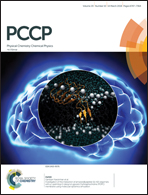Electric field analyses on monolayer semiconductors: the example of InSe†
Abstract
External electric fields can be used to manipulate the electronic properties of two-dimensional (2D) materials. 2D InSe semiconductors possess high electron mobility and wide band gap tunability. Therefore, they have been proposed for use in ultrathin electronic devices. Here, using first-principles calculations, we study the charge polarization, structure, electronic structure, and gas adsorption of an InSe monolayer under vertical electric fields. We find that both the structural evolution and charge polarization rely on the directions of the electric fields. The hole effective mass at the valance band maximum can be decreased by fields that offer a possible route to increase mobility. In contrast, the fields have little impact on the effective mass of electrons at the conduction band minimum. Therefore, high electron mobility in InSe is retained under the fields. Besides, electric fields could alter the absorption intensity for gas molecules. Therefore, gas sensors could be an expected application. More importantly, this work systematically points out some key steps for setting up electric-field calculations in the popular VASP code, such as the cancellation of the symmetrisation of the charge density, avoiding electrons spilling out into the vacuum under high fields.



 Please wait while we load your content...
Please wait while we load your content...